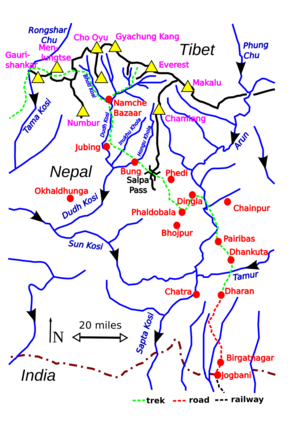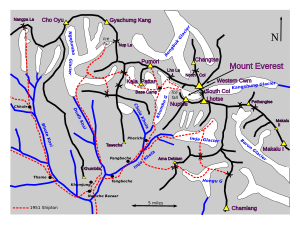1951 British Mount Everest reconnaissance expedition facts for kids
The 1951 British Mount Everest reconnaissance expedition was an adventure to explore Mount Everest. It happened from August 27 to November 21, 1951. The team was led by Eric Shipton. Their main goal was to find a good way to climb Mount Everest from Nepal.
They looked at many possible paths. They decided the best route was through the Khumbu Icefall, the Western Cwm, and the South Col. This path was later used by climbers from Switzerland in 1952. It was also the route for the successful British climb in 1953.
Contents
Exploring Mount Everest from Nepal
After World War II, things changed for climbers. Tibet closed its borders, but Nepal became more open. This meant explorers could finally look for climbing routes from the Nepal side of Everest.
In 1950, two climbers, Charlie Houston and Bill Tilman, went on an informal trip. They reached what is now Everest Base Camp on the Khumbu Glacier. Their report was not super hopeful about reaching the top from there. But they still thought a climb might be possible.
What Climbers Knew in 1951
By 1951, people knew where the South Col was. They had seen it from the east in Tibet and from photos taken from the air. But no one had seen its western side. There were three main parts of the route through the Western Cwm that climbers did not know much about. These were the Khumbu Icefall, the climb up to the South Col, and the final climb to the top.
The best information about the Icefall came from Tilman and Houston. They were the only ones who had seen it up close. They thought it was hard but could be climbed. The Western Cwm had been seen a few times. But it was not clear if its floor was flat or sloped up. A slope might make climbing harder.
For the final ridge, Houston and Tilman saw a very steep ridge. It looked almost impossible to climb. But they thought it might be hiding the real path from the South Col to the summit. The 1921 expedition had seen the South Col from the east. They thought a ridge from there to the summit looked easier.
In early 1951, Michael Ward studied old photos and maps. He found some secret photos taken by the RAF in 1945. One photo showed the north face of Lhotse. It also showed the area between the Western Cwm and the South Col. Another photo showed a wide, snowy ridge. This ridge stretched from the summit down to the South Col.
Getting Ready for the Expedition
Based on these photos, Michael Ward suggested a new expedition. He wanted a team to check these areas on the ground. The Himalayan Committee was not keen on asking Nepal for permission. They were surprised when Nepal said yes. Ward believed the committee hoped Nepal would say no.
Bill Murray was supposed to lead the team. The first members were Ward, Campbell Secord, Tom Bourdillon, and Alfred Tissierès. But then Eric Shipton joined. He was asked to be the leader instead. Shipton's good name helped get money from The Times newspaper.
Shipton himself did not think they would find a route. He thought the chances were very low. But he really wanted to visit Solu Khumbu. This was where his Sherpa friends lived. Secord and Tissierès had to drop out. Shipton wanted a small team. So, the group ended up with only Shipton, Tom Bourdillon, Bill Murray, and Michael Ward.
Later, Shipton agreed to take two more climbers. These were Earle Riddiford and Ed Hillary from New Zealand. They quickly joined the team. With Ang Tharkay as their sirdar (leader of the Sherpas) and twelve Sherpas, the main group left Jogbani on August 27, 1951. The New Zealanders met them on September 8 at Dingla.
Hillary was nervous to meet Shipton, a very famous climber. He worried he might not fit in with the English team. Hillary later wrote, "My first feeling was one of relief. I had rarely seen a more disreputable bunch."
The Expedition's Journey
Khumbu Glacier and Icefall Exploration
The team followed the same path as Houston and Tilman. They made a small change at Dingla to avoid a washed-out bridge. After a month of trekking in the rainy season, they reached Namche Bazaar. On September 30, Shipton and Hillary climbed high enough on Pumori. From there, they got their first good view up the Western Cwm.
The Cwm sloped up to about 23,000 feet. This was 2,000 feet higher than they expected. This meant a climb up the Lhotse glacier would lead to the South Col. This was good news. But the Icefall still looked like a big problem. Even so, Hillary was already thinking about trying for the summit in 1952.
Meanwhile, Riddiford and Sherpa Pasang found a way through most of the lower icefall. But on October 4, Shipton, Hillary, Riddiford, Bourdillon, and three Sherpas were about 30 feet from the top of the icefall. A small avalanche made Shipton decide to turn back. He did not want to risk the lives of the Sherpas. They were not experienced enough to understand the dangers. Shipton felt they had found a possible route. But it could not be tried with all the deep snow. He also wanted to see if there were other ways to the top from the east or west.
Exploring Everest's Southern Areas
Ward, Bourdillon, Riddiford, and Murray started a three-week trek. They went west from the Khumbu valley. They were trying to find the Chola Khola. They had been told (wrongly) that there was a pass into Tibet at the head of this valley. But their map was wrong. They had actually reached the Ngojumba glacier. This glacier is the main source of the Dudh Kosi river, at the foot of Cho Oyu. They went north along Cho Oyu's east face. But they could not see a path to its summit. They then headed for Nup La. But two large icefalls slowed them down. So they gave up and went back to Namche Bazaar. They also improved the maps of the Chola Khola area.
Meanwhile, Shipton and Hillary went down the Khumbu. Then they traveled east up the Imja glacier. This glacier is south of the Lhotse–Nuptse wall. They hoped to find a pass to the Barun glacier. From there, they hoped to find another pass west of Pethangse. But they found no way to cross to the Barun. So they went south down the Hongu glacier. They eventually reached the Barun. They were too far south to reach Pethangtse in time. So they returned to Khumbu by crossing the south ridge of Ama Dablam.
The whole team met up again. They tried once more to climb the Khumbu Icefall. But they found that a lot of ice had fallen. The area was very unstable. A few days later, on October 28, conditions were better. They reached the top of the icefall. But they found a 100-yard-wide crack. This crack split the glacier from side to side. It separated it from the almost flat glacier in the Western Cwm. They turned back. They thought ice conditions might be more stable for a spring expedition. This would be after the winter snows had settled. On October 30, they were back at Namche Bazaar.
Journey to Kathmandu
The team planned to go home through Kathmandu to the west. So they traveled through an unknown area. This was between the Bhote Koshi river of Sola Khumbu and the Rongshar valley in Tibet. They crossed a new pass and named it the Menlung La. One small trip reached the Nangpa La. This pass was in the wrong place on their map. They also saw two possible routes up the northwest face of Cho Oyu. Another group found and named Menlungtse. They also found and photographed some animal tracks they could not identify. The Sherpas said these were from a yeti. Passing north of Gaurishankar, they headed southwest and then west. They reached Kathmandu on November 21.
What Happened Next
Planning for the 1953 Expedition
While still exploring the Khumbu Icefall, Shipton told the Himalayan Committee good news. He said they had found "a practical route from the West Cwm to the summit of Mount Everest." They planned to climb in 1952. However, Nepal had already given permission to a Swiss team for 1952. Shipton went to Zurich to share his findings with the Swiss. They talked about a combined Swiss-British team, but it did not happen.
Instead, Nepal gave permission for the British to climb Cho Oyu in 1952. Then they could try Everest in 1953. This worked out well for the British. They would not have been ready in 1952. The Swiss also shared helpful advice about the mountain.
The 1952 Swiss Mount Everest expedition almost reached the top. This made the British climbing community very focused on their 1953 chance. Especially since France had permission for 1954. Shipton was well-known and popular. He seemed like the clear leader. But he had wider interests than just Everest. After Cho Oyu, he did not go home. He kept trekking with Hillary.
Back in London, things were changing. Some climbers, including some from the Cho Oyu trip, talked to the Himalayan Committee. They felt Shipton lacked strong leadership and planning in 1952. The Committee agreed.
The most likely new leader was John Hunt. He was an army colonel with climbing experience in the Karakoram and the Alps. He had climbed very high before. He was known for his good organization skills. He was also friends with some committee members. Another option was Charles Wylie. He was a climber who spoke Nepalese well. He became the organizing secretary. Both Hunt and Wylie were in the Army. So they were good at planning and could be available quickly.
When Shipton returned home, he met with the Himalayan Committee on July 28, 1952. He did not know his leadership was being questioned. His main opponents were not there. No one wanted to tell him what was happening. Shipton himself said he had doubts about leading. He liked small, exploratory trips, not competitive ones. Still, the committee said he was their choice for leader. They also supported his idea for Charles Evans to be co-leader.
Behind the scenes, Hunt was offered the co-leadership. When Shipton and Hunt met, they found out they had been told different stories. They were both upset. Hunt thought his chance at Everest was gone. At the next committee meeting, Shipton's friends were not there. Shipton was asked to leave the room while they talked about the leader. When he came back, he was told he could only be a co-leader. And even that role would end once they reached Base Camp. They told him they needed someone with "dynamic personality, drive and enthusiasm." The Committee then sent a message to Hunt, making him the leader. They did not wait for Shipton's reply. Shipton decided not to join the expedition.
Many climbers were very upset. Bourdillon resigned from the 1953 expedition. But Shipton convinced him to change his mind. Hillary sent a message saying, "Consider change most unwise." He felt New Zealand climbers owed Shipton a lot. However, Murray, while disagreeing with the committee's methods, privately thought Hunt would be a better leader. Hunt returned to London in October. He began preparing for the 1953 British Mount Everest expedition.
Images for kids





